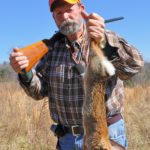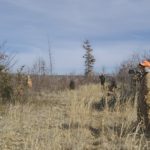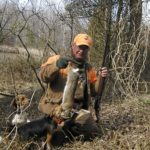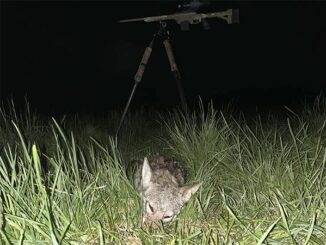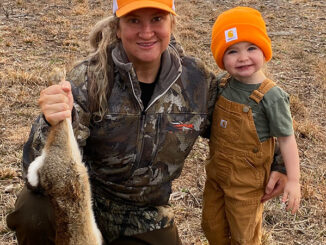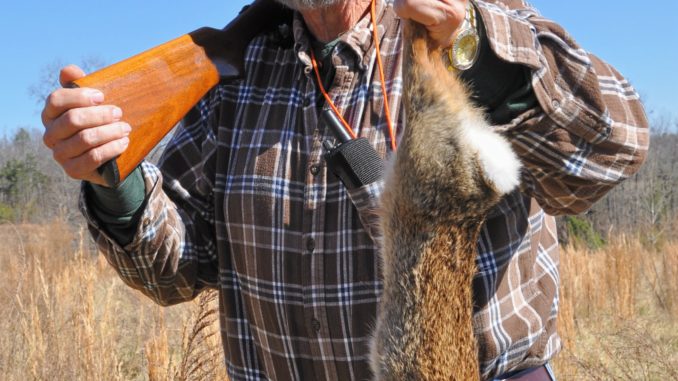
Rabbit populations in the Carolinas are made up of several species, but all provide plenty of opportunities this month.
If Alex Trebek unveiled this clue on his TV quiz show, Jeopardy, would you come up with the correct question?
“Name the wild rabbits that live in the Carolinas.”
Most people would ring in and respond “What is a cottontail?” But that wouldn’t put money in your column. If you happened to have grown up east of the fall lines in both states and responded, “What are cottontails and marsh rabbits?” you’d almost cash in.
But to take home the money, you’d have to respond “What are Appalachian and eastern cottontails, marsh rabbits and swamp rabbits?”
Hunters in South Carolina have the opportunity to hunt all four species, while North Carolina hunters have only the two cottontails and marsh rabbits, aka “bluetails” or “canecutters.”
Bunches o’ bunnies
“In South Carolina, we’ve got marsh rabbits and swamp rabbits,” Michael Hooks, the small-game biologist for the S.C. Department of Natural Resources.
According to SCDNR, swamp rabbits have been documented only in the Savannah River drainages in Oconee, Pickens and Anderson counties. Appalachian cottontails are found only at higher elevations in Oconee, Pickens and Greenville counties.
Swamp rabbits are as large as marsh rabbits but have fuzzy, white tails, similar to a cottontail. True marsh rabbits are the largest specimens in both states and have small, stubby, brown tails.
“We call every big rabbit a swamp rabbit,” Hooks said.
Thomas Boyd, a rabbit hunter from Saluda, S.C., agreed.
“Most of (our) rabbits are cottontails,” he said. “Others are swamp rabbits. We occasionally get a bluetail in there. Most of them we find in swampy areas.”
The vast majority of North Carolina rabbits are eastern cottontails, and while swamp rabbits are missing, marsh rabbits are plentiful, found in isolated pockets in the Piedmont and across eastern counties. Although they don’t necessarily live near marshes, they prefer nearby water, especially creeks.
“We always find ’em with a large creek or shallow river close by, so if the dogs push them too hard and force them out of their favorite habitat, they can find a creek and swim across,” said hunter Pete Acosta of Graham, N.C. “If your beagles run a bluetail too hot, he’ll run out of thick stuff, head for the nearest creek and swim across.”
Appalachian cottontails, the smallest of the four sub-species, are found mostly in higher elevations in the mountains of western North Carolina.
Public-land bunnies
SCDNR and the N.C. Wildlife Resources Commission manage many public lands — Wildlife Management Areas in South Carolina and Game Lands in North Carolina —for small game, including rabbits.
“Crackerneck WMA near Aiken is a good place for rabbits,” Hooks said.
Crackerneck’s 10,000 acres feature small-game fields scattered across 7,000 acres of upland habitat. The remaining land is 3,000 acres of swamps.
“A good bit of it has been clear cut and thinned,” Hooks said. “It’s got older clear cuts, a fair amount of bottomland and some grown-over field edges.”
In South Carolina, make sure you consult the regulations digest (www.dnr.sc.gov/regulations.html) for WMA hunting dates. While many WMAs operate under the same statewide season dates as private lands, many have different dates. Crackerneck, for example, is open to public hunting on Fridays and Saturdays.
“Draper WMA in York County contains only 806 acres, but (we) started years ago doing a little quail habitat work, and it’s got a fairly dedicated group of rabbit hunters,” Hooks said. “Draper has native, warm-season grasses and dove fields, lots of habitat for small game and rabbits.”
Palachucola WMA in Hampton and Jasper counties and Hamilton Ridge WMA in Hampton County “also have good rabbit hunting and prescribed dates,” Hooks said.
Fant’s Grove WMA near Clemson in the Upstate “has decent rabbit hunting,” Hooks said. “We plant quail food plots there and don’t mow them, so they’re good for rabbits.”
North Carolina’s two million acres of public hunting lands include plenty of areas with good habitat for rabbits. Most seasons mimic those on private lands, except in the case of some areas where hunting for all species is restricted to certain days (www.ncwildlife.org/Hunting/Where-to-Hunt/Public-Places).
On one of North Carolina’s best public-hunting areas, the 61,225-acre Sandhills Game Land along US 1 south of Raleigh, rabbit hunting is allowed only on the field-trials grounds and only from Nov. 11-25.
Similar to South Carolina WMAs, North Carolina’s game lands with dove fields feature habitat that suits rabbits.
“If a game land’s got dove fields, you can count on it having rabbits,” said David Turner, a biologist in the eastern part of the state.
The Green Swamp Game Land in Brunswick County has classic habitat where managed loblolly pines have been planted after old-growth timber cuts and undergrowth has been kept manageable by controlled burns.
Chowan Swamp Game Land in Bertie, Gates and Hertford counties has excellent rabbit areas at the Gates County side of the Chowan River and near Parkers Ferry. Some regions of Gull Rock Game Land in Hyde County, including the Long Shoal Tract, offer cottontails and bluetails.
The two top game lands for rabbits in eastern North Carolina are likely Holly Shelter Game Land in Pender County, the Croatan National Forest in Carteret, Craven and Jones counties.
“Butner-Falls of Neuse Game Land (north of Durham) has rabbits, but it gets pounded so hard it’s only good for two or three days,” said Chris Baranski, a Commission biologist who oversees Northern Piedmont counties.
Jordan Game Land southwest of Raleigh has seven dove fields, and all have habitat suitable for rabbits.
Caswell Game Land in Casewell County has eight dove fields with good field-edge cover, and a CURE (quail restoration) area.
“Except for the restricted zone, the CURE area can be hunted for rabbits,” Baranski said. “It’s got regenerating clear cuts for rabbits. The dove field off Old 62 south of Yanceyville has hedge rows and warm-season grasses.”
A surprising game lands for marsh rabbits is a section of Harris Game Land in Chatham County. On the west side of Corinth Road where it turns south off old US 1, Shaddox Creek runs through this region, along with a powerline cut-through covered in sawtooth briars. The area also has high ground and cottontails.
In the western third of the state, Sandy Mush Game Land in Buncombe and Madison counties has six dove fields in the French Broad River bottomland that hold rabbites, and the South Mountains Game Lands in Burke, Cleveland, McDowell and Rutherford counties also offers good rabbit hunting.

